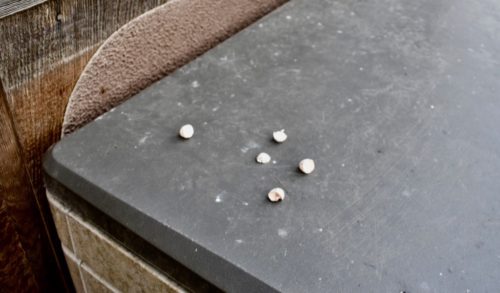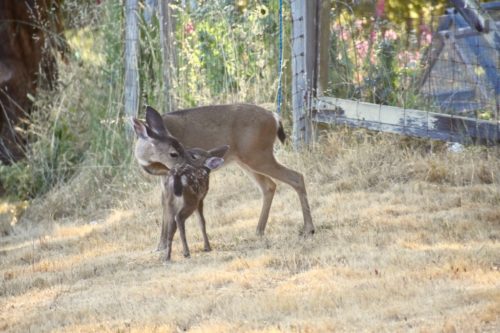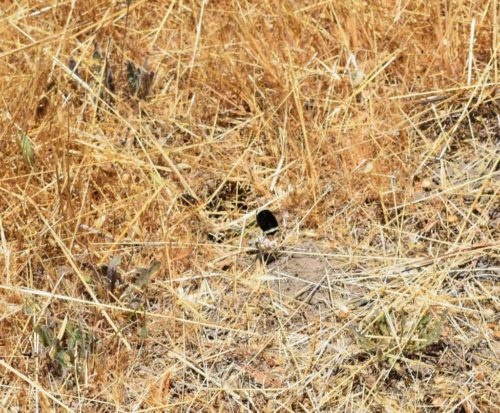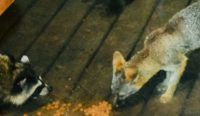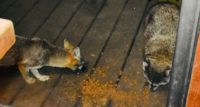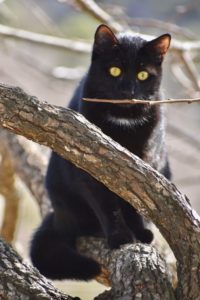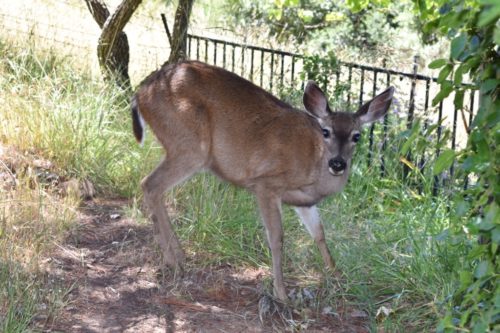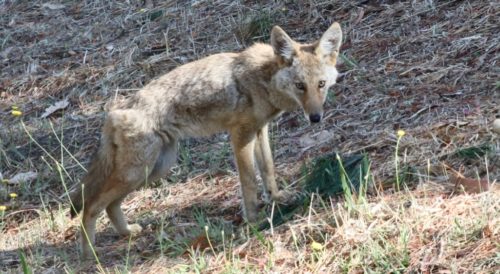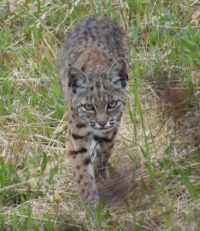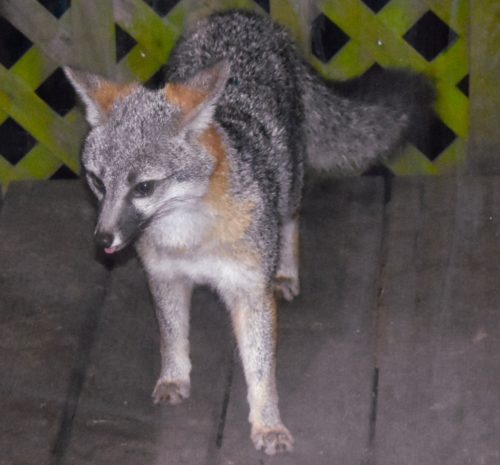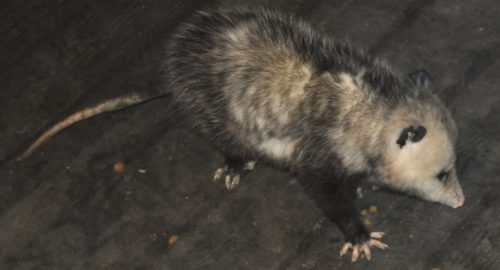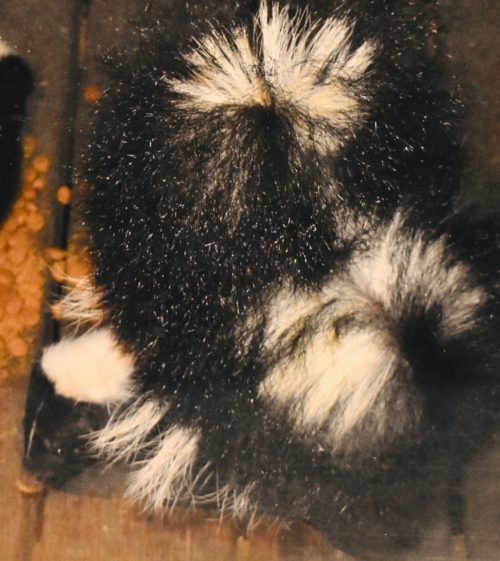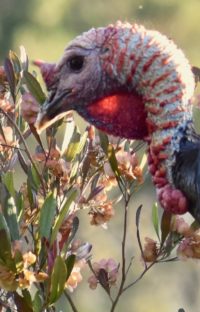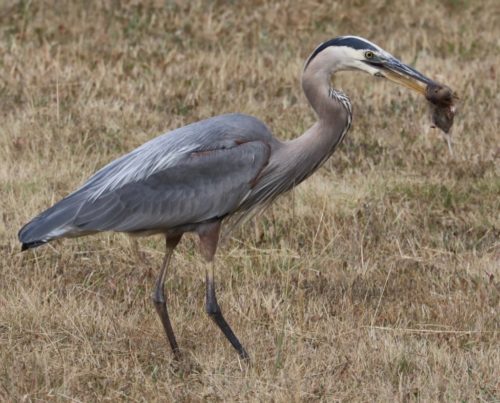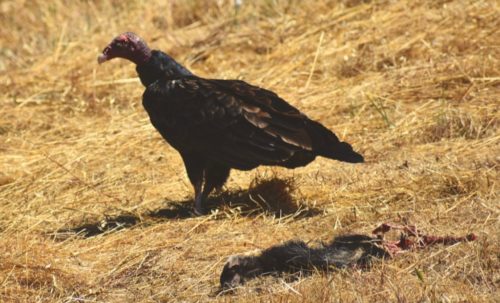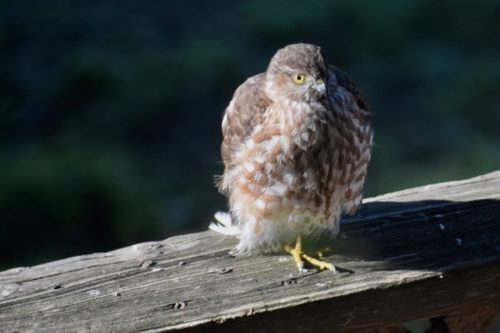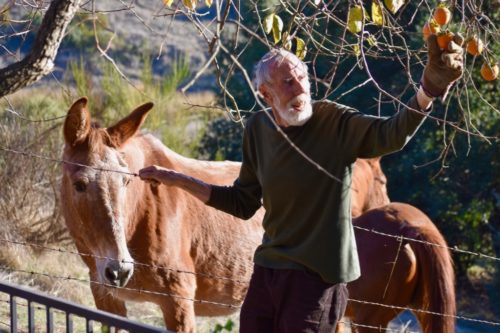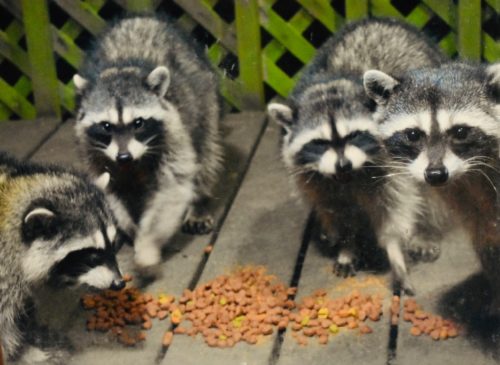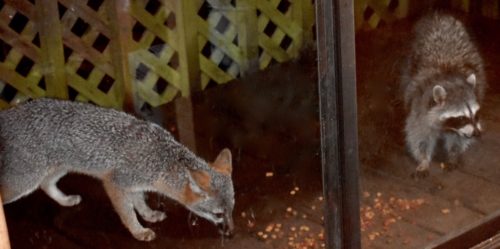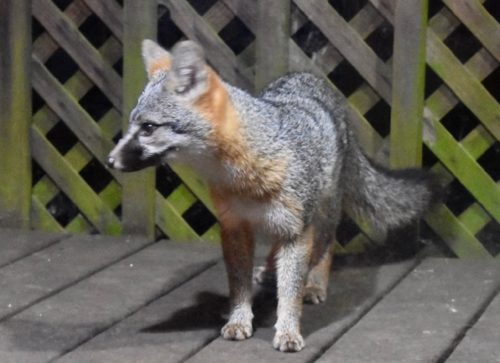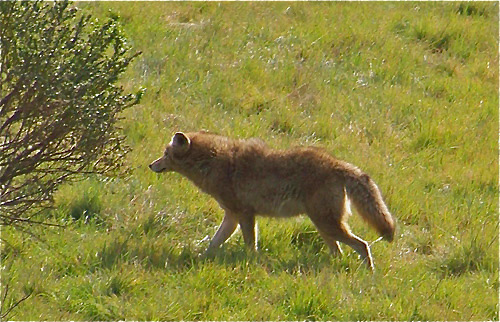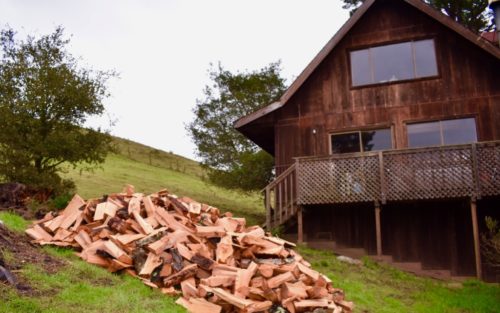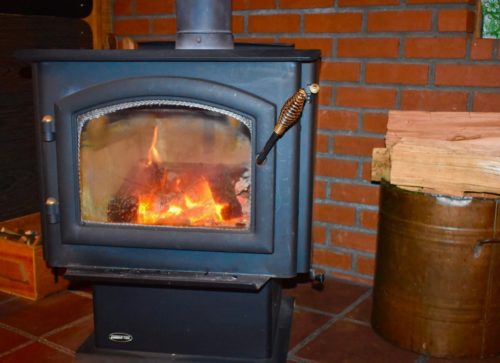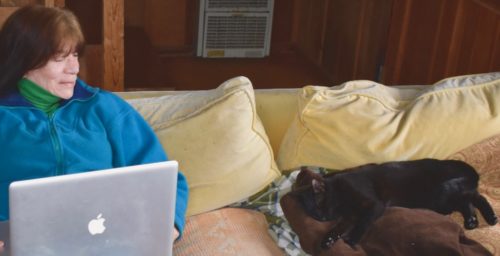Entries tagged with “foxes”.
Did you find what you wanted?
Fri 14 Oct 2022
Posted by DavidMitchell under General News, Personal, West Marin nature, Wildlife
Comments Off on Birds, birdseed & roof rats, foxes & raccoons
The San Francisco Chronicle on Thursday carried a front-page story headlined, ‘Birdseed Lady to blame for rat swarms?’ The Chronicle reported a woman, who “appears to be experiencing mental illness,” daily leaves “mounds of birdseed throughout [the] commercial corridor” of the Glen Park neighborhood.
In doing so, she appears to be “fomenting the area’s formidable rat and pigeon problems.” As the article noted, city government still hasn’t figured out how to deal with her even though “city law forbids spreading birdseed in public places.”
The problem is more than esthetic. “The issue exploded into public view this month when health inspectors temporarily shuttered Canyon Market, Glen Park’s posh and popular grocery store, after finding gnawed pasta bags, rat droppings, and other evidence of a severe rodent infestation.”

I’ve seen the pattern on a small scale at Mitchell cabin. The birdseed Lynn and I put on our deck daily for our feathered neighbors also draws a handful of roof rats.
The birds such as this towhee act as if the roof rats were just other birds and are quite content to eat alongside them.
The birds also share their bath with the rats, who like to take sips from it.
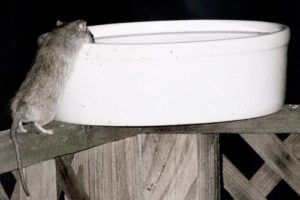
So far the roof rats are not an insurmountable problem although they do nibble on flowers Lynn planted in our garden and — worse yet — on the wiring for her car’s engine.
The rats are amazingly predictable. We tend to put out seed around 5:30 p.m. daily, and the roof rats show up around 6:30 p.m.
————————
Among the other trends in wildlife around Mitchell cabin are changes in the fox community, which had mostly kept out of sight during the past couple of years. Foxes, nonetheless, made their presence known by frequently peeing on my morning Chronicle. It’s all about marking territory. Thank goodness subscriptions are delivered in plastic bags.

Last week I spotted two foxes together on our deck until they were scared off when two young raccoons got into a noisy tiff.
————————
A young man in town told me he wants to wear a pest-control uniform for Halloween. I told him to gopher it.
Have you ever wondered why cats eat fur balls. They do it because they love a good gag.
And why do bears have hairy coats? Fur protection, of course.
Fri 7 Jan 2022
Caveat lectorem: When readers submit comments, they are asked if they want to receive an email alert with a link to new postings on this blog. A number of people have said they do. Thank you. The link is created the moment a posting goes online. Readers who find their way here through that link can see an updated version by simply clicking on the headline above the posting.
This is a belated review of an entertaining linguistic book, A Charm of Goldfinches and Other Wild Gatherings. It was originally published five years ago by Ten-Speed Press. My wife Lynn gave it to me for Christmas. The author, Matt Sewell, is a Canadian ornithologist, illustrator, and artist who has exhibited in London, Manchester, New York, Tokyo, and Paris.

As most of us know, a group of geese is called a “gaggle” but if the geese are flying in formation, the proper term is “skein,” writes Sewell. The term “comes from an old French word for ‘V’ Formation.”

Some group names are grim but accurate. Here a “wake” of vultures divvy up a skunk killed by an owl.

Virtually every night at Mitchell cabin we can hear a “band” of coyotes howling.
Groups of coyotes are called “bands” although to my mind, “choirs” would be more accurate. Sewell notes that “outside of their guarded family units, coyotes hang together in unrelated gangs, scavenging and doing whatever coyotes do.”

A “sulk” of foxes atop a shed at Toby’s Feed Barn. These were spotted by postal staff outside a postoffice window.

A “plague” of rats. Given my recent experience with roof rats, I would second the group name “plague.” Roof rats found their way into my car’s engine compartment around Christmas and chewed wiring, piled up debris, and damaged the car’s computer. The final tab at garages in Point Reyes Staton and Santa Rosa to repair the damage came to more than $2,500.

A “trip” of rabbits.
Sewell frequently indulges his ironic sense of humor. Describing how groups of rabbits came to be called “trips,” Sewell writes: “Now, some of you may be thinking: the trip would be to follow the white rabbit down the rabbit hole. Â Sadly not: this term is from the 15th century, not the 1960s Jefferson Airplane lyric, or even Lewis Carroll’s Alice in Wonderland, which inspired the song. It is, in fact, about as psychedelic as a turnip patch.
“A colony of rabbits is a flighty bunch, not surprisingly, as the whole world is their enemy…. They are rarely safe for long, not when they’re hunted by hawks and owls, weasels, foxes, domestic pets, and humans, to name just a few.”
As noted previously, “jackrabbit” is short for “jackass rabbit,” a nickname it got because of its ears.
A “ lounge” of lizards. This is a blue-belly lizard on the wall of our cabin.
lounge” of lizards. This is a blue-belly lizard on the wall of our cabin.
Lizards are cold-blooded “so they need to warm up from the sun or on warm stones.”
“It’s this lounging that gets them into trouble though as lizards are easy prey in this laid-back state.
“If they are cruelly snatched, lizards at least have a last-gasp mechanism for freedom: they can release their tail, which will wriggle around in the predator’s mouth, confusing the daylights out of it while the lizard makes a dash for the undergrowth.”
I hope it gets there safely.
Sat 26 Jun 2021
Posted by DavidMitchell under Uncategorized
1 Comment
Caveat lectorem: When readers submit comments, they are asked if they want to receive an email alert with a link to new postings on this blog. A number of people have said they do. Thank you. The link is created the moment a posting goes online. Readers who find their way here through that link can see an updated version by simply clicking on the headline above the posting.
_________________________
As often happens, just when I was wondering what to blog about this week, the wildlife around Mitchell cabin showed up to provide material.

A cliff swallow sails up to a nest under our eves. Over the past month, swallows have built the nest two stories up over our kitchen.

By now, the first clutch of eggs has hatched. Given how high the nest is, Lynn and I found it amazing that parts of three shells landed fairly intact on a woodbox below after being pushed out when no longer needed. A bit of blood can be seen in the near shell.
From what I read, “The breeding season for swallows lasts from March through September. They often produce two clutches per year, with a clutch size of 3 to 5 eggs. Eggs incubate between 13 and 17 days, and the chicks, fledge in 18 to 24 days.”
This makes me suspect we’ll see another crop of chicks this summer,
_______________________

A blacktail doe and one of her fawns nuzzling each other struck Lynn and me as an extremely happy scene. However….

Lynn was far less happy when the doe and fawns headed to the nasturtium bed she recently planted, forcing her to start walking up to the deer family before they moved on.
_______________________

A bumblebee heads downhill to its swarm’s hole in the dirt. When we were getting the fields around Mitchell cabin mowed and weed whacked on June 10, as was reported here, the workers did a great job but had to leave one patch of grass untrimmed; when they went near it, they were met by a swarm of bumblebees. By being alert, I was able to sneak into the patch twice a few days later to finish the job. In the process, I finally located their well-hidden nest. I’d not seen one before.
_______________________


Some oddities are always the same, so to speak. Last week I posted the photo at left of a raccoon and fox I’d seen dining together just outside our kitchen door 10 days ago. Thursday night I spotted the same dinner companions but with positions reversed. There’s nothing like a few handfuls of kibble to bring about inter-species harmony.
Fri 19 Feb 2021
Posted by DavidMitchell under Uncategorized
Comments Off on Looking animals in the eye
This week we’ll look animals, both domestic and wild, in the eye to get a sense of what they see.

Newy, the stray cat we’ve taken in and who has been mentioned here before, can have an intense gaze when she’s looking off at something. It’s noticeable enough that it prompted me to look into, so to speak, the eyes of not only cats but other animals as well. A cat’s vision is not as all-powerful as it appears. A cat is most sensitive to blues and yellows and does not see colors like red, orange, or brown.

A blacktail doe looks up from grazing outside our bedroom window. The pupils in a deer’s eyes are horizontal, not round, and a flash camera makes them look blue.

A coyote displays his predatory nature as he stares into a field. As it happens, just now as I type this, coyotes are howling outside Mitchell cabin. (Photo by neighbor Dan Huntsman)

The no-nonsense look of a bobcat in the field below Mitchell cabin.

Foxes too are predatory, but their gaze makes them appear more curious than vicious.

Possums have good night vision but don’t distinguish between colors very well. Overall, their vision is so weak they must depend on smell and touch to find food.

Skunks, like possums, have very poor vision and navigate largely via their senses of smell and hearing.

Wild turkeys, on the other hand, see in color and “have an excellent daytime vision that is three times better than a human’s eyesight and covers 270 degrees,” according to ‘Facts about Wild Turkeys.’ “They have poor vision at night, however, and generally become warier as it grows darker.”

‘Livingbird Magazine’ reports that “Great Blue Herons can hunt day and night thanks to a high percentage of rod-type photoreceptors in their eyes that improve their night vision.” Near Mitchell cabin, a gopher with the baleful stare of death hangs from the heron’s beak.

Buzzards have such “keen eyesight,” Seaworld claims, that “it is believed they are able to spot a three-foot carcass from four miles away on the open plains.”

A stern stare. Coopers Hawks are skillful hunters and like other hawks have excellent vision.

The smirk of a Western Fence Lizard (also known as a Blue Belly for obvious reasons). It’s one of the most common lizards around Mitchell cabin. As for their vision, most lizards have excellent eyesight, and some can see into the UV spectrum.

Somehow my work glove hand ended up on the persimmon, and my bare hand on the barbed-wire fence. (Photo by Lynn Axelrod Mitchell)
This moment became a test of my vision and not in looking at the persimmons growing between the fields of Mitchell cabin and Arabian Horse Adventures. After some staring, I concluded that the Arabian waiting patiently for a persimmon is, in fact, a female mule. Nonetheless, I eventually gave her some fruit. Later I found out the mule had arrived in the pasture not long ago after its owner died. So far I’ve never seen any of the stable’s trail riders on it. Arabian Mule Adventures.
Tags: animal eyesight, blacktail deer, blue belly, buzzards, Cooper's hawk, foxes, Great blue heron, jackrabbit, mule, possum, skunks, Western fence lizard
Thu 28 Jan 2021
Posted by DavidMitchell under Uncategorized
[2] Comments
In the words of the poet Ezra Pound (1885-1972), “Winter is icumen in,/ Lhude sing Goddamm,/ Raineth drop and staineth slop,/ And how the wind doth ramm!/ Sing: Goddamm.”

In Inverness, 2.5 inches raineth Tuesday night with the wind ramming hard. On Laurel Avenue in Inverness Park, the wind blew down a tree that crushed contractor David Cordrey’s work van (seen here). In the San Geronimo Valley, winds gusted to 73 mph in Woodacre and 72 mph in Lagunitas. A travel-trailer occupant in Lagunitas, Jay Cimo, was knocked unconscious and suffered a brain injury when the wind toppled a tree onto the trailer.

In Inverness, a falling tree also destroyed a footbridge beside Inverness Way. The wind gusted to 59 mph in Inverness. The gusts brought down power lines in both Inverness and Bolinas.

Before the storm, a family of raccoons showed up on the deck at Mitchell cabin, so I gave them handfuls of kibble.

This, in turn, brought in a fox who dined alongside the raccoons.

The local fox is fun to look at, but he has a bad habit of marking his territory by peeing on our morning San Francisco Chronicle, which thankfully comes in a plastic bag. Obviously removing the newspaper from the bag must be done with care. Equally unsettling, the fox has taken to pooping on our deck at night. Better on the deck than the newspaper, for I certainly wouldn’t want to deal with sh*tty-fox news morning after morning.

Other members of the dog family (Canidae) are coyotes such as this one walking up to a patch of coyote brush near Mitchell cabin. We hear them most nights but see them only occasionally. What we are starting to see more often is coyote scat in the field below the cabin.

I’m certainly glad it’s in the grass and not on our deck or newspaper.

Worried that high winds could topple two dead pines along our driveway, I recently hired Nick Whitney and his Pacific Slope crew to cut them down and buck them up for firewood. Our neighbors Skip and Renée Shannon followed suit by having yet another neighbor, George Grim Jr., cut a tree, buck, and split it. Grim also split the trees I had cut down. With the Shannons contributing their tree (piled above), Lynn and I are accumulating quite a firewood collection, including three smaller stacks.

For the most part we use a woodstove to heat the cabin, so the bonanza of logs is most welcome.

Enjoying the warmth, Lynn sits by the fire with Newy, the stray cat we took in last year.
Mon 6 Jan 2014
I’m using the start of the new year as an occasion to exhibit a number of wildlife photos I’ve shot around Mitchell cabin during the past three or four years. I make no pretense to having produced photographic masterpieces, for I still use a Kodak EasyShare, a primitive digital camera that’s no longer made.
Wild animals in unlikely juxtapositions, whether deliberate or serendipitous, are some of my favorite subjects, so let’s begin with a few.
Deer in particular are curious about other creatures that are not big enough to be threatening. Friendships such as that of Bambi and Thumper are not all that unusual in the real world. Indeed, I once saw a young deer trying to cozy up to a jackrabbit; the rabbit, however, retreated under a bush when the fawn got too close.
 Here a blacktail doe sticks around to watch Linda Petersen’s late Havanese named Sebastian when the dog wandered down my driveway.
Here a blacktail doe sticks around to watch Linda Petersen’s late Havanese named Sebastian when the dog wandered down my driveway.
__________________________________________________________________
 The blacktail around Mitchell cabin appear particularly interested in housecats.
The blacktail around Mitchell cabin appear particularly interested in housecats.
Here a nosy doe watches a cat on a woodpile cleaning its fur.
__________________________________________________________________
 Deer and housecats seem pretty much at ease around each other, somewhat in the same way that deer get along with cows and horses.
Deer and housecats seem pretty much at ease around each other, somewhat in the same way that deer get along with cows and horses.
________________________________________________________________

A bit more surprising, to me at least, was seeing this doe and great blue heron hunting together in my pasture. The deer was there to dine on new clumps of green grass while the heron was there to dine on gophers. ________________________________________________________________

Some creatures, however, need encouragement to fraternize. Foxes and raccoons aren’t terribly fond of each other, but they will show up to the same feast, which in this case consisted of honey-roasted peanuts I’d scattered on the deck. __________________________________________________________________

Possums and raccoons are even less companionable under normal circumstances. If a raccoon gets too close, a possum will often bare its fangs although it’s all a bluff. But both critters will peaceably attend ecumenical dinners when honey-roasted peanuts are served. _________________________________________________________________

Possums, in fact, can be convinced to undertake almost any endeavor if the reward is honey-roasted peanuts. In one notable case, I was able to use sweet-roasted goobers to teach a possum table manners. __________________________________________________________________

One of the most popular photos I ever posted involved my using the same peanuts to encourage a bodhisattva possum along his path to enlightenment. Word of the photograph must have gotten around. For months after I posted it, one of the more-frequently Googled terms bringing people to this blog was “bodhisattvva possum.” __________________________________________________________________

Turning now to birdbaths. A towhee keeps its feathers in good condition by washing in the birdbath on the deck of Mitchell cabin. Such ablutions are why we call the these basins birdbaths. _________________________________________________________________

And, of course, many birds count on birdbaths for their source of drinking water. Here a mourning dove leaves the birdseed to a towhee for a moment while it takes several gulps. Because so much of their food is dry, these birds need regular drinks to wash it down. I place a couple of bricks in the birdbath for birds that like to stand in water. ___________________________________________________________________

Birds are not the only creatures who use the basin for bathing and as a source of drinking water. I’ve seen as many as four raccoons squeeze into the birdbath to wash their paws after eating. Here three kits balance effortlessly 15 feet above the ground on the narrow railing of my deck as they clamber in and out of the basin at night. ______________________________________________________________________

Nor do I discriminate. My birdbath also provides drinking water for any creature that can get to it. Honeybees frequently show up to drink although a few inevitably fall in.
Probably the drinkers with the worst reputation are the roof rats. These rats originated in southern Asia, and you’ll recall it was their fleas that spread the Black Death throughout Europe in the 14th Century, killing roughly half the people.
I don’t mind roof rats’ drinking from the birdbath and stealing birdseed from my deck, but I’ve periodically had to trap rats that got into my basement. The problem is their unfortunate habit of gnawing on everything chewable from paper to dishwasher drain hoses to electrical-wire insulation.
It’s really too bad they’re such nuisances because, as you can see, they’re awfully cute.
Mon 18 Jun 2012
Summer will begin on Wednesday, so it is appropriate that a full array of wildlife, especially young wildlife, has been showing up at Mitchell cabin. On Sunday, two adult quail and eight chicks scurried in front of my partner Lynn Axelrod and me as we were about to get into my car.

Sunday evening, a female raccoon, which shows up on our deck each evening for a tray of kibble, surprised us by bringing along four kits. The kits were only a few months old, but already they revealed differing personalities. One brave kit followed right behind its mother as she prowled the deck. Another spent much of its time hiding behind our woodbox.
Raccoons tend to mate around the end of winter, with kits being born about two months later. Baby raccoons are born deaf and blind. Their ear canals open in about three weeks, and their eyes open a few days later.
Kits are usually weaned by the time they’re four months old although they stay with the mother until late fall while she shows them burrows and feeding grounds. After that, the kits, especially the males, begin leaving the family group and setting out on their own.

The mother, whom we had previously dubbed Samantha, tends to be remarkably relaxed on our deck. She often falls asleep leaning up against the glass door to our kitchen and is prone to eating like Roman nobility, lying on her side and sticking a paw into the food.

A couple of foxes also show up on our deck each evening, and they like to be hand fed slices of bread; however, they also like the raccoons’ kibble.
 Samantha jealousy guards the kibble until she becomes satiated and loses interest in it.
Samantha jealousy guards the kibble until she becomes satiated and loses interest in it.
At right she enjoys an after-dinner snooze notwithstanding a fox eating her kibble.
Lynn and I have seen a fox grab a slice of bread out from under the tail of a raccoon, and we have seen raccoons grab bread that was intended for a fox.
While both species are wary of each other, they’ll often run past each other only a few inches apart.

Even when one doesn’t see them, Western gray squirrels, such as this, often make their presence known by nibbling the tips off pine branches. The squirrels like to eat the cambium layer, which is immediately below the bark, and in the process eat through the tips, which then fall to the ground.
Are squirrels dangerous? Quoting Komsomolskaya Pravda newspaper, the BBC in 2005 reported: “Squirrels have bitten to death a stray dog which was barking at them in a Russian park. Passersby were too late to stop the attack by black squirrels in a village in the far east.
“They are said to have scampered off at the sight of humans, some carrying pieces of flesh. A pine cone shortage may have led to the squirrels to seek other food sources, although scientists are skeptical.”
Did the attack really happen? Whatever happens in Russia, to quote Winston Churchill, “is a riddle wrapped in a mystery inside an enigma.” All I can tell you is that squirrels are omnivorous and will eat small birds, along with acorns. Moreover, Komosmolskaya Pravda reported that just a few months earlier, chipmunks had “terrorized cats” in the area.

Also making its presence known around Mitchell cabin of recent is this jackrabbit seen here on our front steps.
Point Reyes Station naturalist Jules Evens notes in his book The Natural History of the Point Reyes Peninsula that the large jackrabbits, also known as black-tailed hares, around here have “elongated hind limbs” which enable them to “spring long distances and make sharp turns. To avoid predation, the black-tail uses an element of surprise and escape that works well.”

“When a potential predator is detected, the hare will usually take shelter in the shade of a convenient clump of vegetation or behind a rock and freeze, motionless. If the predator approaches very closely, the hare leaps into stride, zig-zagging across open country until it finds shelter.”

“The effect on the startled predator is momentary confusion, which may afford the hare the advantage it needs to escape.” In contrast, its cousin the cottontail or brush rabbit has “relatively poor running ability,” Evens adds. They “rarely venture far from bushes, to which they retreat for safety when danger approaches.
“Nevertheless, this species frequently falls prey to foxes, bobcats, weasels, hawks, and owls.” I personally have seen cottontails peeking out from chaparral beside roads in the Point Reyes National Seashore and beside Highway 1 south of Stinson Beach.

With so many critters wanting to eat rabbits, where does the idea come from of a lucky rabbit’s foot? The tradition of carrying a rabbit’s foot as an amulet has long been practiced in Europe (since 600 BC), North America, South America, China, and Africa.
The superstition in North America is believed to have originated with African magic known as hoodoo, and not just any foot will do. It has to be the left, hind foot.
Some people believe that for its foot to be an effective good-luck charm, the rabbit must have been shot or captured in a cemetery. The phase of the moon can also be important. Some believe the rabbit must be killed during a full moon while others say it must be a new moon. Still others insist the rabbit must be killed on a Friday, a rainy Friday, or on a Friday the 13th.
This rabbit, as can be seen, considers the luckiest use of its left hind foot is for hopping away from potential danger.
Mon 6 Feb 2012
 Last week I reported that a Guatemalan wife and mother of two, Cristina Siekavizza (at right), disappeared July 7.
Last week I reported that a Guatemalan wife and mother of two, Cristina Siekavizza (at right), disappeared July 7.
Authorities suspect she was murdered by her husband, Roberto Barreda de Leon, and that he has probably fled to the United States, taking the couple’s two children, Roberto Jose, 7, and Maria Mercedes, 4, with him.
As I wrote, I became interested in the case because my former wife Ana Carolina Monterroso is a friend of Cristina’s relatives. She and Cristina’s brother Pablo have notified me that roughly 25,000 people are currently using social media to track down Roberto.
I believe it. Last week’s posting drew a record 1,217 visitors in the first three days after it went online. Some 432 of those were in Guatemala. Readers have posted links to this blog on their Facebook pages and on other websites. Truly social media in action.

An international warrant for the English-speaking husband’s arrest has been issued. If people spot him, they should notify local law enforcement or the FBI. Please note that the email address in Guatemala for reporting his whereabouts is incorrect on the wanted poster. It should be busquedacristina@gmail.com.
 Point Reyes Station. Mitchell cabin with its red roof is near the center of the photo.
Point Reyes Station. Mitchell cabin with its red roof is near the center of the photo.

Around Mitchell cabin two foxes are making themselves more and more at home with every passing week. Lynn and I can hand feed them slices of bread although one is more skittish than the other. The first sits around the kitchen door waiting for me to hand it dinner. Usually we have to throw the slices to its partner.
 For a year or more we had been feeding our foxes and raccoons honey-roasted peanuts along with bread, but that became fairly expensive.
For a year or more we had been feeding our foxes and raccoons honey-roasted peanuts along with bread, but that became fairly expensive.
Our problem was solved by Gayanne Enquist of Inverness.
She recommended we forget about peanuts and feed our critters dog kibble. It was a brilliant idea.
Once we determined through experimentation which brand they prefer, Kibble and Bits, we could eliminate peanuts and most bread from their dinners.
However, the kibble is so popular that we might as well be feeding two large dogs.
Along with the foxes, we get five or six raccoons every night.
One raccoon is a solitary male. The others belong to two families that don’t like each other, so we have to put out two trays of kibble on the deck and keep refilling them.
That adds up to about 40 pounds of kibble per week.
The foxes wait their turn for the kibble until the raccoons leave although the raccoons are also a bit wary of the foxes.

Of course, we’re not always Johnny on the spot in setting out their dinners, and here a fox waits patiently while a raccoon approaches cautiously.

We also feed a variety of birds, including towhees, sparrows, doves, and scores of redwing blackbirds. They have a set feeding time, somewhere between 4:30 and 5 p.m. However, the birds aren’t the only beneficiaries of the birdseed. Roof rats, those cute little rodents, show up almost as soon as the blackbirds leave.

Blacktail deer are ubiquitous around Mitchell cabin. This year I’ve seen as many as 14 at one time. Here a fawn sleeps right outside our kitchen window while two does graze nearby.
The deer are so comfortable around us that I can often approach them within a few feet.
Although we’re in the middle of winter, these are great days to relax. Just keep your eyes out for a murder suspect fleeing Guatemala.
Tue 22 Nov 2011
When Lynn and I returned home from a visit to my optometrist in Terra Linda last week, we found a mirthful message on our answering machine from Linda Sturdivant of Inverness Park. “Hey Dave,” she said. “I want to tell you about something beautiful I saw yesterday.
“As I was leaving here, I got to the end of the levee road. At the pumpkinhouse, there is one of the most beautiful red trees you could ever see. Get a picture.”
The pumpkinhouse gets its nickname from the pumpkin displays that once were on its front porch and fence every year. If you check Janis Ceresi’s comment, she includes a link that shows what the pumpkin house used to look like on Halloween.

Wanting more information regarding the tree’s location, I called Linda back, and a friendly young woman answered. Not recognizing her voice, I asked, “Is this Linda?” She said she was. “Just where is this beautiful tree?” I asked, and she sounded confused. “Which tree?” she responded. “The one you called me about.” She then asked me, “Where are you?” and I replied, “In Point Reyes Station.”
“Well, I’m in San Francisco,” she said. We both laughed and hung up, and I called the real Linda Sturdivant.

The tree Linda saw is not the only one around here with brilliant fall colors. This allée of maple trees is across Highway 1 from Campolindo Road, where I live.
 Last week I had just started down my front steps when I heard a commotion in a pyracantha bush on Doreen Miao’s property uphill from mine. Not sure what I was seeing, I grabbed my camera and started snapping photos.
Last week I had just started down my front steps when I heard a commotion in a pyracantha bush on Doreen Miao’s property uphill from mine. Not sure what I was seeing, I grabbed my camera and started snapping photos.
 Before long the source of the disturbance became obvious when a flock of wild turkeys fluttered to the ground. What had they been doing up in the bush? I was surprised that the bush’s bitter berries are safe to eat, so I checked the Seasonal Cooking website. “Contrary to a common myth, they are not poisonous,” the site said. “Pyracantha, a relative of apples and roses, is entirely edible.” In fact, you can use the berries to make preserves and jelly.
Before long the source of the disturbance became obvious when a flock of wild turkeys fluttered to the ground. What had they been doing up in the bush? I was surprised that the bush’s bitter berries are safe to eat, so I checked the Seasonal Cooking website. “Contrary to a common myth, they are not poisonous,” the site said. “Pyracantha, a relative of apples and roses, is entirely edible.” In fact, you can use the berries to make preserves and jelly.
 As we head toward winter, a variety of wildlife has begun hanging around just outside the cabin. I photographed this blacktail buck just below our deck. In addition, a doe and her fawn are so comfortable here that I can walk within a few yards of them.
As we head toward winter, a variety of wildlife has begun hanging around just outside the cabin. I photographed this blacktail buck just below our deck. In addition, a doe and her fawn are so comfortable here that I can walk within a few yards of them.

Last week I was looking out my kitchen window when I spotted this bobcat looking back at me.
 It’s been awhile since I’ve seen a bobcat so close to Mitchell cabin, but it didn’t seem to mind my presence and soon resumed hunting.
It’s been awhile since I’ve seen a bobcat so close to Mitchell cabin, but it didn’t seem to mind my presence and soon resumed hunting.
Another predator that I haven’t seen for more than a year showed up this week. I didn’t see the coyote, but I found its scat in my driveway. Neighbor George Stamoulis found a fair amount of coyote scat in his driveway and saw the animal itself moseying up Campolindo Road.
Last night, Lynn and I spotted still another creature that hasn’t been around for months. A young possum showed up on my deck to eat the remainder of peanuts Lynn had put out for raccoons. Raccoons and grey foxes have become so common during the evening at Mitchell cabin that they’ve become fairly comfortable with us. We can feed them slices of bread by hand with no problem.
I’ll close on a linguistic fact I learned from the WildCare magazine this week. There is a name for the burbling sounds mother raccoons and their young make among themselves. It’s called trilling, as in Lionel, and we’ve heard it many times.
Tue 2 Aug 2011
In researching his 2008 book Vital Diversities: Balancing The Protection of Nature and Culture, Inverness writer Mark Dowie later recounted in the West Marin Review, “A Yupik native scientist [in Alaska] told me, ‘We have no word for ‘wilderness.’ What you call wilderness, we call our backyard.'”
 This mother raccoon brought her three kits to my deck for the first time a week ago.
This mother raccoon brought her three kits to my deck for the first time a week ago.
The Yurik concept of wilderness makes perfect sense to me. My backyard, even my deck, could easily be called “wilderness.”
 My wilderness includes deer in my fields on a daily basis. On rare occasions I’ve seen coyotes, bobcats, and badgers, and every night a group of smaller animals shows up on my deck.
My wilderness includes deer in my fields on a daily basis. On rare occasions I’ve seen coyotes, bobcats, and badgers, and every night a group of smaller animals shows up on my deck.
The critters at night are usually foxes, raccoons, and possums looking for bread or peanuts.
It’s often easy to hear the call of the wild in my backyard. Some alpha males, especially among red-winged blackbirds and raccoons, seem more intent on driving other males away from food than with getting some for themselves.
The second time the three kits showed up (right), their mother was not with them.
Before long, an adult raccoon began growling at them, and they took refuge in a narrow gap between my woodbox and the wall of my cabin. When the adult stuck around, they were too frightened to leave, so I finally went outside. This caused the adult to run off a short distance and provided the kits with a chance to escape.
After all, someone has to keep order on my deck, and it’s fallen to me to enforce the law of the wild.

The foxes get along with each other better than the raccoons do, and because they’re not intra-species rivals, the raccoons will often eat side by side with foxes when I put out peanuts. I’ve even had a possum join in, creating an ecumenical dinner for local wildlife.
Red-winged blackbirds look over my deck prior to landing on it.
Every day in the late afternoon I put out birdseed, which attracts pigeons, doves, quail and juncos, but most of all it brings in bluejays, towhees and red-winged blackbirds.
 The birdseed also attracts roof rats. These cute little critters with long tails are amazingly good at climbing walls and railings, jumping onto the picnic table, and squeezing through tiny openings.
The birdseed also attracts roof rats. These cute little critters with long tails are amazingly good at climbing walls and railings, jumping onto the picnic table, and squeezing through tiny openings.

A fortnight ago, Linda Petersen of Inverness, ad manager of The West Marin Citizen, took a week’s vacation and left her Havanese dog Eli in the care of my girlfriend Lynn and me.
Late one afternoon, he, Lynn and I were sitting on my deck at sunset when Eli spotted one of the roof rats, which spotted Eli at the same time. I grow flowers on my deck in wine-barrel halves, and the rat scurried under one of the barrels. Immediately Eli was sniffing under the barrels, barking and growling.
It was pandemonium. While Eli would try to drive a rat out from under one barrel, another rat would pop out from under a nearby barrel and dash across my deck to safety. Before he was done, Eli had flushed seven roof rats. It was an exciting drama, but it made me glad that, at least for the moment, I’ve been able to seal off my basement against the rats. For now, they show up only when the birdseed is first scattered.

Quietly watching the drama but staying out of it was this Western fence lizard on my wall. It moved very little, depending on its coloring for camouflage. Fence lizards, I should note, are often dark when they first get up in the morning and become lighter as the day grows warmer. Kind of like the rest of us.


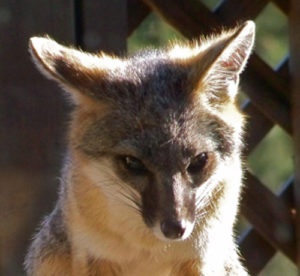


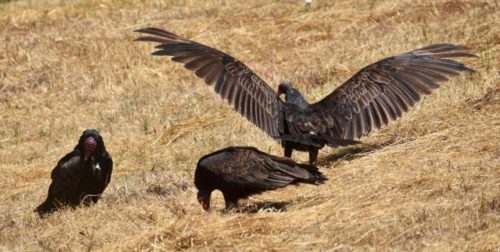
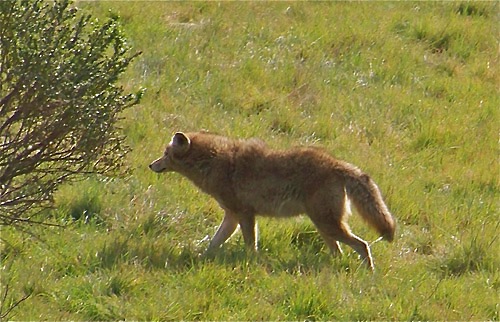
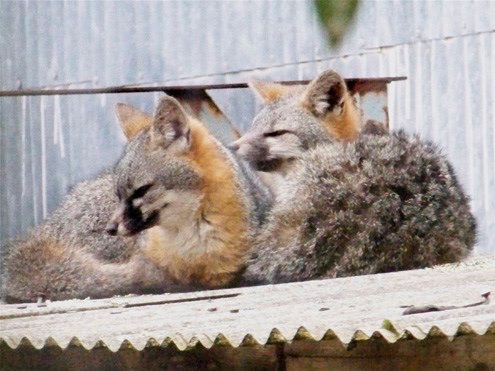
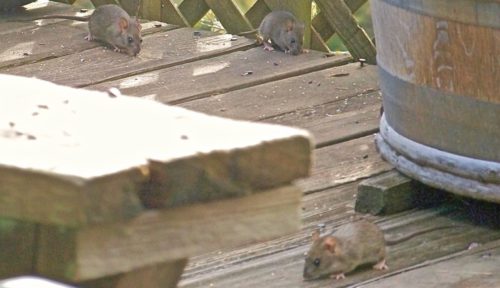
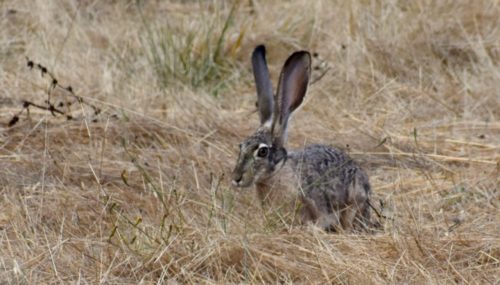
 lounge” of lizards. This is a blue-belly lizard on the wall of our cabin.
lounge” of lizards. This is a blue-belly lizard on the wall of our cabin.
